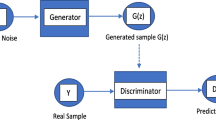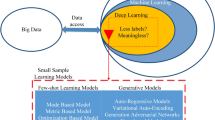Abstract
In disease detection, generative models for data augmentation offer a potential solution to the challenges posed by limited high-quality electroencephalogram (EEG) data. The study proposes a temporal-spatial feature-aware denoising diffusion probabilistic model (DDPM), termed TF-DDPM, as an EEG time-series augmentation framework for autism research. The module for predicting noise is CCA-UNet based on the channel correlation-based attention (CCA) mechanism, which considers the spatial and temporal correlation between channels, and uses depthwise separable convolution instead of traditional convolution, thereby suppressing the interference from irrelevant channels. Visualization and binary classification results on synthetic signals indicate that proposed method generates higher quality synthetic data compared to Generative Adversarial Networks (GAN) and DDPM.
Access this chapter
Tax calculation will be finalised at checkout
Purchases are for personal use only
Similar content being viewed by others
References
Luo, Y., Lu, B.: EEG data augmentation for emotion recognition using a conditional Wasserstein GAN. In: 2018 40th Annual International Conference of the IEEE Engineering in Medicine and Biology Society (EMBC), pp. 2535–2538 (2018)
Lee, W., Lee, J., Kim, Y.: Contextual imputation with missing sequence of EEG signals using generative adversarial networks. IEEE Access 9, 151753–151765 (2021)
Yu, W., et al.: Morphological feature visualization of Alzheimer’s disease via multidirectional perception GAN. IEEE Trans. Neural Netw. Learn. Syst. 34(8), 4401–4415 (2023)
Jamal, W., et al.: Using brain connectivity measure of EEG synchrostates for discriminating typical and Autism Spectrum Disorder. In: Proceedings of the 2013 6th International IEEE/EMBS Conference on Neural Engineering (NER), pp. 1402–1405 (2013)
Jamal, W., Das, S., Oprescu, I.A., Maharatna, K., Apicella, F., Sicca, F.: Classification of autism spectrum disorder using supervised learning of brain connectivity measures extracted from synchrostates. J. Neural Eng. 11(4), 046019 (2014)
Truong, D., Makeig, S., Delorme, A.: Assessing learned features of Deep Learning applied to EEG. In: Proceedings of the 2021 IEEE International Conference on Bioinformatics and Biomedicine (BIBM), pp. 3667–3674 (2021)
Chlap, P., Min, H., Vandenberg, N., Dowling, J., Holloway, L., Haworth, A.: A review of medical image data augmentation techniques for deep learning applications. J. Med. Imaging Radiat. Oncol. 65(5), 545–563 (2021)
Kebaili, A., Lapuyade-Lahorgue, J., Ruan, S.: Deep learning approaches for data augmentation in medical imaging: a review. J. Imaging 9(4), 81 (2023)
Garcea, F., Serra, A., Lamberti, F., Morra, L.: Data augmentation for medical imaging: a systematic literature review. Comput. Biol. Med. 152, 106391 (2023)
Hu, B., Zhan, C., Tang, B., Wang, B., Lei, B., Wang, S.: 3D brain reconstruction by hierarchical shape-perception network from a single incomplete image. IEEE Trans. Neural Netw. Learn. Syst. 1–13 (2023)
Goodfellow, I., et al.: Generative adversarial nets. In: Ghahramani, Z., Welling, M., Cortes, C., Lawrence, N., Weinberger, K.Q. (eds.) Advances in Neural Information Processing Systems 27, vol. 27. Curran Associates, Inc. (2014)
You, S., et al.: Fine perceptive GANs for brain MR image super-resolution in wavelet domain. IEEE Tran. Neural Netw. Learn. Syst. 1–13 (2022)
Hu, S., Lei, B., Wang, S., Wang, Y., Feng, Z., Shen, Y.: Bidirectional map** generative adversarial networks for brain MR to PET synthesis. IEEE Trans. Med. Imaging 41(1), 145–157 (2022)
Hu, S., Yu, W., Chen, Z., Wang, S.: Medical image reconstruction using generative adversarial network for Alzheimer disease assessment with class-imbalance problem. In: 2020 IEEE 6th International Conference on Computer and Communications (ICCC), pp. 1323–1327 (2020)
Hu, S., Shen, Y., Wang, S., Lei, B.: Brain MR to PET synthesis via bidirectional generative adversarial network. In: Martel, A.L., et al. (eds.) MICCAI 2020. LNCS, vol. 12262, pp. 698–707. Springer, Cham (2020). https://doi.org/10.1007/978-3-030-59713-9_67
Wang, S., Shen, Y., Zeng, D., Hu, Y.: Bone age assessment using convolutional neural networks. In: 2018 International Conference on Artificial Intelligence and Big Data (ICAIBD), pp. 175–178 (2018)
Panwar, S., Rad, P., Quarles, J., Huang, Y.: Generating EEG signals of an RSVP experiment by a class conditioned Wasserstein generative adversarial network. In: Proceedings of the 2019 IEEE International Conference on Systems, Man and Cybernetics (SMC), Bari (2019)
Zhang, K., et al.: Data augmentation for motor imagery signal classification based on a hybrid neural network. Sensors 20(16), 4485 (2020)
Panwar, S., Rad, P., Jung, T.-P., Huang, Y.: Modeling EEG data distribution with a Wasserstein generative adversarial network to predict RSVP events. IEEE Trans. Neural Syst. Rehabil. Eng. 28(8), 1720–1730 (2020)
Wang, S., et al.: An ensemble-based densely-connected deep learning system for assessment of skeletal maturity. IEEE Trans. Syst. Man Cybern. Syst. 52(1), 426–437 (2022)
Arjovsky, M., Chintala, S., Bottou, L.: Wasserstein generative adversarial networks. In: Precup, D., Teh, Y.W. (eds.) Proceedings of the 34th International Conference on Machine Learning, vol. 70, pp. 214–223. JMLR (2017)
Ho, J., Chen, X., Srinivas, A., Duan, Y., Abbeel, P.: Denoising diffusion probabilistic models. ar**v:2006.11239 (2020)
Shu, K., Zhao, Y., Wu, L., Liu, A., Qian, R., Chen, X.: Data augmentation for seizure prediction with generative diffusion model. ar**v:2306.08256 (2023)
Tosato, G., Dalbagno, C.M., Fumagalli, F.: EEG synthetic data generation using probabilistic diffusion models. ar**v:2303.06068 (2023)
Author(s): Brain Signal Generation and Data Augmentation with a Single-Step Diffusion Probabilistic Model. Paper under double-blind review, presented at ICLR (2023)
Pelphrey, K.: Multimodal Developmental Neurogenetics of Females with ASD. NIMH Data Archive. (2012). https://nda.nih.gov/experiment.html?id=196 &collectionId=2021
Alcaraz, J.M.L., Strodthoff, N.: Diffusion-based conditional ECG generation with structured state space models. ar**v preprint ar**v:2301.08227 (2023)
Wang, S., Chen, Z., You, S., Lei, B.: Brain stroke lesion segmentation using consistent perception generative adversarial network. Neural Comput. Appl. 34, 8657–8669 (2022)
Gong, C., et al.: Generative AI for brain image computing and brain network computing: a review. Front. Neurosci. 17 (2023)
Miao, Z., Zhao, M.: Time-space-frequency feature Fusion for 3-channel motor imagery classification. ar**v preprint ar**v:2304.01461 (2023)
Torma, S., Szegletes, L.: EEGWave: a Denoising Diffusion Probabilistic Approach for EEG Signal Generation. EasyChair (2023)
Yan, Y., et al.: Topological EEG nonlinear dynamics analysis for emotion recognition. IEEE Trans. Cogn. Dev. Syst. 15(2), 625–638 (2023)
Li, Y., Zhang, X.R., Zhang, B., Lei, M.Y., Cui, W.G., Guo, Y.Z.: A channel-projection mixed-scale convolutional neural network for motor imagery EEG decoding. IEEE Trans. Neural Syst. Rehabil. Eng. 27, 1170–1180 (2019)
Zhang, C., Kim, Y.K., Eskandarian, A.: EEG-inception: an accurate and robust end-to-end neural network for EEG-based motor imagery classification. J. Neural Eng. 18, 046014 (2021)
Shovon, T.H., Nazi, Z.A., Dash, S., Hossain, F.: Classification of motor imagery EEG signals with multi-input convolutional neural network by augmenting STFT. In: Proceedings of the 5th International Conference on Advances in Electrical Engineering (ICAEE), Dhaka (2019)
Acknowledgements
This work was supported by the National Natural Science Foundations of China under Grant 62172403, the Distinguished Young Scholars Fund of Guangdong under Grant 2021B1515020019, the Excellent Young Scholars of Shenzhen under Grant RCYX20200714114641211.
Author information
Authors and Affiliations
Corresponding author
Editor information
Editors and Affiliations
Rights and permissions
Copyright information
© 2023 The Author(s), under exclusive license to Springer Nature Singapore Pte Ltd.
About this paper
Cite this paper
Li, Y., Liao, I.Y., Zhong, N., Toshihiro, F., Wang, Y., Wang, S. (2023). Generative AI Enables the Detection of Autism Using EEG Signals. In: Jia, W., et al. Biometric Recognition. CCBR 2023. Lecture Notes in Computer Science, vol 14463. Springer, Singapore. https://doi.org/10.1007/978-981-99-8565-4_35
Download citation
DOI: https://doi.org/10.1007/978-981-99-8565-4_35
Published:
Publisher Name: Springer, Singapore
Print ISBN: 978-981-99-8564-7
Online ISBN: 978-981-99-8565-4
eBook Packages: Computer ScienceComputer Science (R0)




